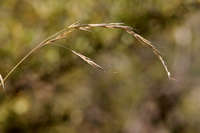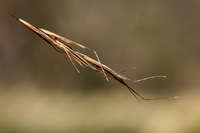|
|
 Seedhead Patrick Alexander @http://swbiodiversity.org, Usage Rights: Creative Commons Attribution-ShareAlike (CC BY-SA) |  Spikelets Patrick Alexander @http://swbiodiversity.org, Usage Rights: Creative Commons Attribution-ShareAlike (CC BY-SA) | | | | |
|
| | |
Origin: Native Season: Cool and Warm
Habitat Description: Grows on rocky slopes and plains, generally in pinyon-juniper, oak, or ponderosa pine communities.
Plant Communities:Desert Scrub, Interior Chaparral, Semidesert Grasslands, Pinyon Juniper Woodland, Montane Conifer Forest
Elevation: 3500 - 7800 feet
Desc:
The several stems are attached at the base of the plant and are usually wide spreading.
Identification Notes: Awns markedly unequal; the lateral awns are absent or less than 1/2 as long as the central awns. The seedheads are 3 to 12 inches long and 1-1/2 to 10 inches wide and hairy at the base of their branches.
Grass Type: Perennial mat or sod-forming Rhizomes: Y Stolons: N
Large Dense Clump (> 2 feet): N Bushy (highly branched): Y
Height with Seedheads: 24 to 36 inches
Seedhead Structure: Branched - open and spreading Seedhead Droops: Y
Flowering Period: Apr - Oct
Number of Flowers per Spikelet: One-flowered Spikelets One-sided: N
Awns: 1/4 inch to 1 inch Three Awns: N Awns Bent: Y
Flower and Seedhead Notes: Seedheads long and narrow, consisting of many slender branches.
Blade Hairy:
N
Blade with White Margins:
N
Blade Cross section:
Flat
Blade Notes:
Blades 3 to 12 inches long, 1/8 inch wide, usually flat, often curled at maturity.
Sheath Hairy:
N
Tuft of Hairs at top of Sheath or Collar:
Y
Ligules:
Hairy
Auricles (Ear-like lobes at collar area:
N
Forage Value:
Although generally poor forage grasses and, because of the calluses, potentially harmful to grazing animals, they are an important source of spring forage on western range-lands. Quail and small mammals eat small amounts of the seed.
|
|